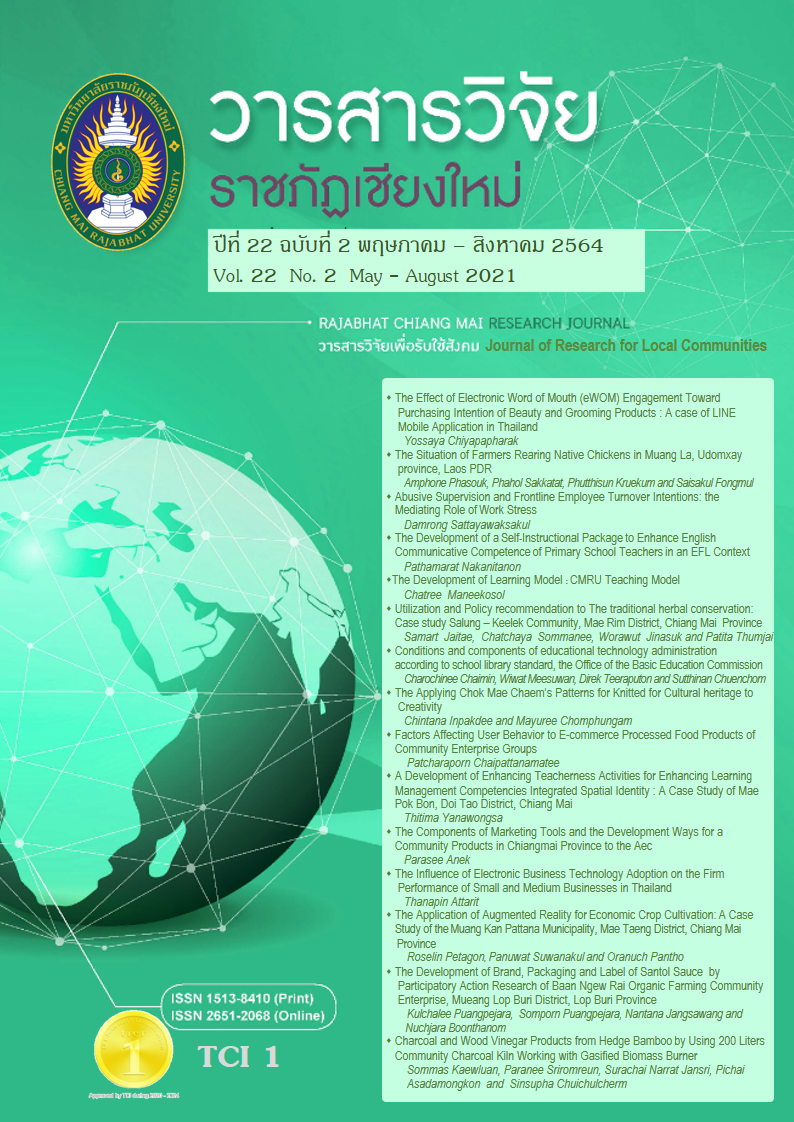The Influence of Electronic Business Technology Adoption on the Firm Performance of Small and Medium Businesses in Thailand
DOI:
https://doi.org/10.14456/rcmrj.2021.246895Keywords:
E- business adoption, Firm performance, SMEAbstract
The purposes of this study was to investigate the influencing of electronic business technology adoption on the firm performance of small and medium businesses in Thailand. A sample was selected from 400 SMEs in Thailand, using stratified random sampling method. Research instrument is questionnaire in order to provide quantitative information for statistics analysis consist of mean, standard deviation that reference by expert and the hypothesis was tested by the multiple regression on Enter method. The results indicated that e-commerce adaptation includes content presentation, transaction activities, customer demand‘s respond, and co-operative with material supplier. Regarding to descriptive and inferential statistics analysis for hypotheses testing, the findings reveal that content presentation, transaction activities, and customer demand’s respond influence firm performance, however, co-operative material supplier do not, at statistically significant 0.01 level.
Downloads
References
Aral, S., & Weill, P. (2007). IT assets, organizational capabilities, and firm performance: How resource allocations and organizational differences explain performance variation. Organization science, 18(5), 763-780. DOI:10.1287/orsc.1070.0306
Aranyossy, M. (2013). E-commerce productivity paradox evidence from the Hungarian retail sector. European Scientific Journal, 9(22), 52-73. https://core.ac.uk/download/pdf/236413264.pdf
Cassetta, E., Monarca, U., Dileo, I., Di Berardino, C., & Pini, M. (2020). The relationship between digital technologies and internationalisation. Evidence from Italian SMEs. Industry and Innovation, 27(4), 311-339. DOI:10.1080/13662716.2019.1696182
Ghobakhloo, M., Sabouri, M. S., Hong, T. S., & Zulkifli, N. (2011). Information technology adoption in small and medium-sized enterprises; an appraisal of two decades literature. interdisciplinary Journal of Research in Business, 1(7), 53-80.
Hair J.F., Black W.C., Babin B.J., Anderson R.E., & Tatham R.L. (2006). Multivariate data analysis. (6thed.) Pearson Prentice Hall. New Jersey.
Hsu, S. H. (2012). Effects of competitive strategy, knowledge management and E-business adoption on performance. The Journal of Human Resource and Adult Learning, 8(2), 42-49. http://www.hraljournal.com/Page/6%20Shu-Hung%20Hsu.pdf
Ilin, V., Ivetić, J., & Simić, D. (2017). Understanding the determinants of e-business adoption in ERP-enabled firms and non-ERP-enabled firms: A case study of the Western Balkan Peninsula. Technological Forecasting and Social Change, 125(1), 206-223. DOI:10.1016/j.techfore.2017.07.025
Kaplan, R. S., & Norton, D. P. (1996). Using the balanced scorecard as a strategic management system. Harvard Business Review, 74(1), 75-85.
Likert, R. (1961). New Patterns of management. New York (McGraw-Hill Book Company).
Limthongchai, P., & Speece, M. (2003). The effect of perceived characteristics of innovation on e-commerce adoption by SMEs in Thailand. In Proceedings of the Seventh International Conference on Global Business and Economic Development, Bangkok, Thailand. (In Thai)
Lin, H. F., & Lee, G. G. (2005). Impact of organizational learning and knowledge management factors on e-business adoption. Management Decision, 43(2), 171-188. DOI:10.1108/00251740510581902
Lin, H. F., & Lin, S. M. (2008). Determinants of e-business diffusion: A test of the technology diffusion perspective. Technovation, 28(3), 135-145. DOI:10.1016/j.technovation.2007.10.003
Madrid‐Guijarro, A., Garcia, D., & Van Auken, H. (2009). Barriers to innovation among Spanish manufacturing SMEs. Journal of small business management, 47(4), 465-488. DOI:10.1111/j.1540-627X.2009.00279.x
Malhotra, M. K., & Grover, V. (1998). An assessment of survey research in POM: from constructs to theory. Journal of operations management, 16(4), 407-425. DOI:10.1016/S0272-6963(98)00021-7
Mohanty, E., & Mishra, A. J. (2020). Understanding the gendered nature of developing country MSMEs’ access, adoption and use of information and communication technologies for development (ICT4D). International Journal of Gender and Entrepreneurship, 12(3), 273-295. DOI:10.1108/IJGE-07-2019-0117
Office of Small and Medium Enterprises Promotion. (2017). Action Plan for Small and Medium Enterprises Promotion by Sector. Retrieved from https://www.sme.go.th/en/ (In Thai)
Oliveira, T., & Martins, M. F. (2010). Understanding e-business adoption across industries in European countries. Industrial Management & Data Systems, 110(9), 1337-1354. DOI:10.1108/02635571011087428
Piyapimonsit, Chatsiri. (2012). Research Proposal. Faculty of Education. Srinakharinwirot University.
Sarkar, S., & Kumar, A. (2009). Techno-economic assessment of biohydrogen production from forest biomass in Western Canada. Transactions of the ASABE, 52(2), 519-530. DOI: 10.13031/2013.26809
Seyal, A. H., & Rahman, M. N. A. (2003). A preliminary investigation of e-commerce adoption in small & medium enterprises in Brunei. Journal of Global Information Technology Management, 6(2), 6-26. DOI:10.1080/1097198X.2003.10856347
Statista. (2020). E-commerce value in Thailand from 2017 to 2018 with a forecast for 2019, by type. Retrieved from https://www.statista.com/statistics/1003739/thailand-e-commerce-value-type
Stevens, J. P. (2012). Applied multivariate statistics for the social sciences. Routledge.
Wu, F., Mahajan, V., & Balasubramanian, S. (2003). An analysis of e-business adoption and its impact on business performance. Journal of the Academy of Marketing science, 31(4), 425-447. DOI:10.1177/0092070303255379
Wu, F., Yeniyurt, S., Kim, D., & Cavusgil, S. T. (2006). The impact of information technology on supply chain capabilities and firm performance: A resource-based view. Industrial Marketing Management, 35(4), 493-504. DOI:10.1016/j.indmarman.2005.05.003
Yamane, T. (1973). Statistics: An introduction analysis. Harper & Row.
Zhu, K., & Kraemer, K. L. (2002). E-commerce metrics for net-enhanced organizations: Assessing the value of e-commerce to firm performance in the manufacturing sector. Information systems research, 13(3), 275-295. DOI:10.1287/isre.13.3.275.82
Zhu, K., & Kraemer, K. L. (2005) Post-adoption variations in usage and value of e-business by organizations: cross-country evidence from the retail industry. Information systems research, 16(1), 61-84.
DOI:10.1287/isre.1050.0045
Zhu, K., Kraemer, K. L., & Xu, S. (2006). The process of innovation assimilation by firms in different countries: a technology diffusion perspective on e-business. Management science, 52(10), 1557-1576. DOI:10.1287/mnsc.1050.0487
Downloads
Published
How to Cite
Issue
Section
License
1. Articles, information, content, images, etc published in the “Community and Social Development Journal” are copyrighted by the Community and Social Development Journal, Chiang Mai Rajabhat University. In order to properly distribute the articles through print and electronic media, the authors still hold the copyright for the published articles under the Creative Commons Attribution (CC BY) license, which allows the re-distribution of the articles in other sources. References must be made to the articles in the journal. The authors are responsible for requesting permission to reproduce copyrighted content from other sources.
2. The content of the articles appearing in the journal is the direct responsibility of the article authors. The editorial board of the journal does not necessarily agree with or share any responsibility.














